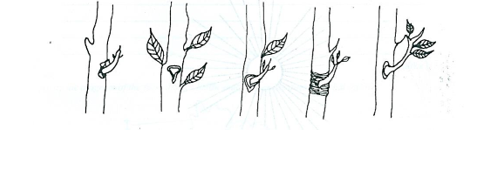Question 1
- (a) Study the experimental set-up illustrated below and answer the questions that follow.

(i) State the aim of the experiment. [1 mark]
(ii) What would happen to the lime water in each of conical flasks I and II at the end of the experiment?. [4 marks]
(iii) What conclusion would be drawn from the experiment? [1 mark ]
(iv)State two ways in which the soil component determined by the experiment is important to soils. [2 marks]
- Below is a sequence of diagrams illustrating a method of crop propagation. Study it and answer the questions that follow.

(i) Name the method of crop propagation illustrated above. [1 mark]
(ii) Mention three crops that could be propagated using the method illustrated above. [3 marks]
(iii) Enumerate three advantages of using the method of crop propagation illustrated above. [3 marks]
Observation
This question was fairly attempted by the candidates. Most of the candidates were able to state the aim of the experiment illustrated by the diagram but they could not state what would happen to the lime water in the conical flasks as required in 1a(i-ii). Also in 1a(iii-iv), most of the candidates were unable to state the conclusion that would be drawn from the experiment but they were able to state the ways in which soil organisms are important to soils. Further to this, most of the candidates were unable to name the method of crop propagation illustrated correctly but they could mention the crops that could be propagated using the illustrated method, though, most of them could not enumerate the advantages of using the method of crop propagation illustrated as required in 1(b)(i-iii).
The expected answers include:
1. (a)(i) What happens in the conical flasks I and II
Conical flask I
Lime water will turn milky indicating that respiration has taken place/carbon dioxide has been released from the soil which reacts with the lime water to turn it milky
Conical flask II
Presence of living organisms/micro-organisms in soils
(iii) Conclusion drawn from the experiment
Conical flask I
Budding
Presence of living organisms/micro-organisms in soils
1. (b)(i) Method of propagation illustrated
Conical flask I
Budding
(iii)Advantages of using the method(Budding)
- The offspring is true to type
- The offspring mature early
- It can be used to propagate crops which have seeds that are not viable
- The method can be used to produce seedless crops
- Desirable characteristics from different plants can be blended into one plant
